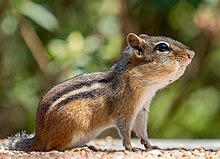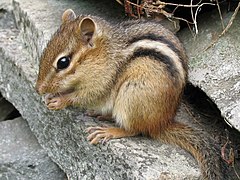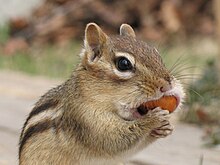
Ground squirrels are rodents of the squirrel family (Sciuridae) that generally live on the ground or in burrows, rather than in trees like the tree squirrels. The term is most often used for the medium-sized ground squirrels, as the larger ones are more commonly known as marmots or prairie dogs, while the smaller and less bushy-tailed ground squirrels tend to be known as chipmunks.
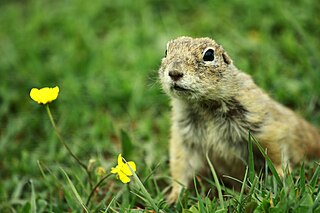
Spermophilus is a genus of ground squirrels in the squirrel family. As traditionally defined the genus was very species-rich, ranging through Europe, Asia and North America, but this arrangement was found to be paraphyletic to the certainly distinct prairie dogs, marmots, and antelope squirrels. As a consequence, all the former Spermophilus species of North America have been moved to other genera, leaving the European and Asian species as true Spermophilus.

The eastern chipmunk is a chipmunk species found in eastern North America. It is the only living member of the genus Tamias.
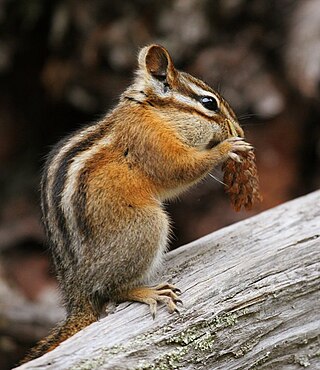
The least chipmunk is the smallest species of chipmunk and the most widespread in North America.

Tamias is a genus of chipmunks in the tribe Marmotini of the squirrel family. The genus includes a single living species, the eastern chipmunk. The genus name Tamias means "treasurer", "steward", or "housekeeper", which is a reference to the animals' role in plant dispersal through their habit of collecting and storing food for winter use.

Eutamias is a genus of chipmunks within the tribe Marmotini of the squirrel family. It includes a single living species, the Siberian chipmunk. The genus is often treated as a subgenus of Tamias, which is now restricted to the eastern chipmunk of North America. Neotamias, which now includes the western North American chipmunks, has also been included in Eutamias.

The Siberian chipmunk, also called common chipmunk, is native to northern Asia from central Russia to China, Korea, and Hokkaidō in northern Japan. It was imported from South Korea and introduced in Europe as a pet in the 1960s.

Palmer's chipmunk is a species of rodent in the family Sciuridae, endemic to Nevada. Its natural habitat is temperate forests. It is threatened by habitat loss. It is named after Theodore Sherman Palmer, an American botanist and zoologist.

The Colorado chipmunk is a species of chipmunk in the squirrel family Sciuridae. It is endemic to Colorado, Utah, Arizona and New Mexico in the United States.
The Siskiyou chipmunk is a species of rodent in the family Sciuridae. It is endemic to northern California and central Oregon in the United States.

The Uinta chipmunk or hidden forest chipmunk, is a species of chipmunk in the family Sciuridae. It is endemic to the United States. Formerly known as Tamias umbrinus, phylogenetic studies have shown it to be sufficiently distinct from the eastern chipmunk as to be placed in a separate genus, Neotamias. The same studies have also suggested that Palmer's chipmunk may actually be a subspecies of Uinta chipmunk, although the two are still generally regarded as separate species.

The Xerinae comprise a subfamily of squirrels, many of which are highly terrestrial. It includes the tribes Marmotini, Xerini, and Protoxerini.

Neotamias is a genus of chipmunks within the tribe Marmotini of the squirrel family. It contains 23 species, which mostly occur in western North America. Along with Eutamias, this genus is often considered a subgenus of Tamias.

The Ezo chipmunk is a subspecies or local population of the Siberian chipmunk; it is found in what was once known as Ezo, namely Hokkaidō, Japan, and Sakhalin and the Southern Kuriles, Russia.
